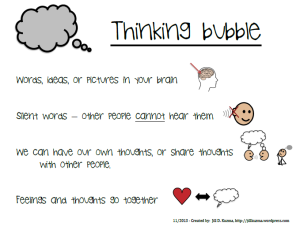This blog is a continuation of the “Eyes and Brain in the Group” blog. As I was attending the Social Thinking © conference in Long Beach in January, I realized that my “Expected and Unexpected Behaviors” lessons were incomplete. In the lessons I used several visuals for Expected and Unexpected Behaviors. I talked about having “good thoughts” when I client demonstrated expected behaviors in the clinic and “bad thoughts” when he exhibited “unexpected behaviors.” But I hadn’t really used a visual to make it explicit. During the conference, I noticed Ryan Hendrix (one of the presenters) use a red thought bubble for “bad thoughts” and a green thought bubble for “good thoughts.” I felt a figurative light bulb go on in my brain. Wouldn’t it make more sense to hold a green thought bubble over my head than say “I am having good thoughts,” since you don’t always express your thoughts verbally. Just holding up the green bubble without verbally interrupting the session would give the client the positive feedback and the acknowledgment while continuing with your lesson.
So of course, the next weekend I had to make the two thought bubbles. I used a generic thought bubble shape I found online and outlined one red and the other green with Do-A-Dot markers to make them bold. I wrote “Yay!” with a smiley face on the green thought bubble and “Oh, no!” with a sad face on the red thought bubble.
I also made a generic (white) thought bubble that said, “I am thinking about __.” I put some Velcro underneath so I child could attach a picture of something/ someone they were thinking about. To carry it further, I also made a “talking bubble” and laminated it so you can write on it with a dry erase marker. The client could write what they were thinking about on the “talking bubble.” For example, if they were thirsty and thinking about juice, they would write, “I want some juice” on the “talking bubble.”
One of my clients in particular has difficulty realizing that people have different thoughts. What is in his brain isn’t necessarily in mine. So if he is thinking about “m&ms,” he needs to say it so I know what he’s thinking about instead of demonstrating “unexpected behaviors” such as screaming or crying. So having two thought bubbles (one for him and one for me), each showing that we are both thinking about different things (his has m&ms, mine has the activity we are doing) makes it explicit for him.
I have to credit Ryan Hendrix for the ideas listed above. I also used Jill Kuzma’s thinking and speech bubbles. You can find the templates on her blog. She has some additional ideas and activities that are great to carry on the lessons using thought bubbles.

